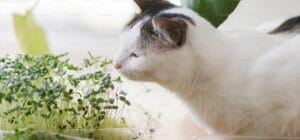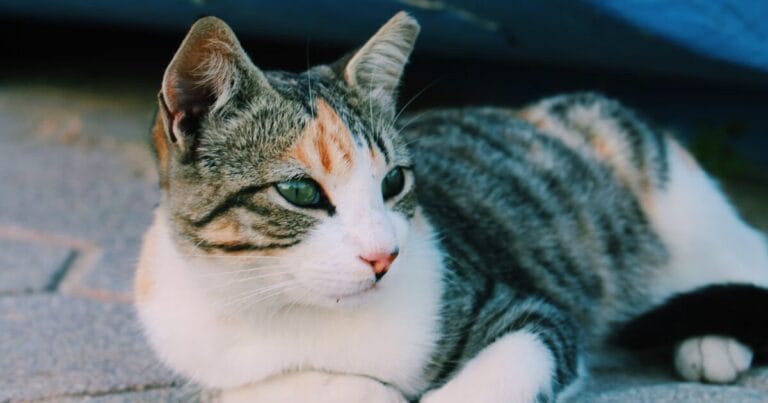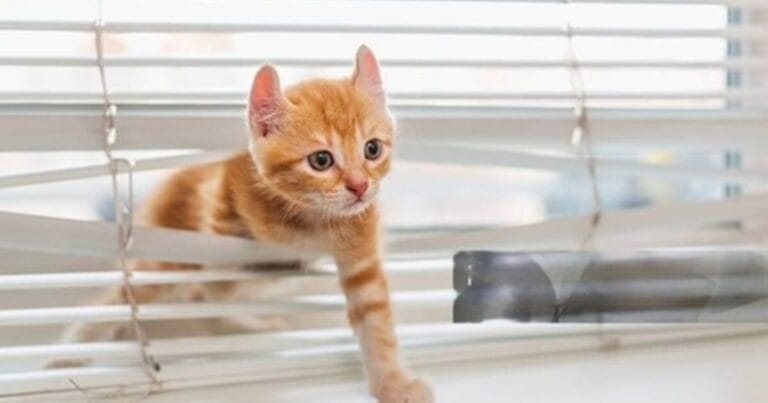When it comes to keeping your beloved houseplants safe from the curious paws of your feline friends, implementing effective strategies is essential. Understanding how to prevent cats from eating plants can help ensure the well being of both your pets and your green companions
This blog post will reveal the tried-and-true methods to prevent cats from turning your beautiful green oasis into their salad bar.
Get ready to say goodbye to those plant-hunting adventures and hello to a harmonious coexistence between your fur baby and your leafy companions!
The Danger Of Cats Eating Plants: Why It’s Important to Prevent It

Cats are curious and playful creatures; their natural instinct is to explore their surroundings. However, this innocent curiosity can often lead to dangerous situations, especially when eating plants.
Many houseplants and outdoor plants are toxic to cats if ingested. It’s essential to be aware of the plants that are toxic to cats. Some common poisonous houseplants include:
- Dieffenbachia (Dumb Cane)
- Pothos (Devil’s Ivy)
- Philodendron
- Peace Lily
- Snake Plant (Mother-in-Law’s Tongue)
- Aloe Vera
- Jade Plant
- Sago Palm
- Oleander
- peace lilies
- Jade plant
These plants contain toxins that can cause various health issues for cats, from mild stomach upset to severe organ damage or even death.
Moreover, even non-toxic plants can still pose a danger if your cat chews on them excessively or eats large quantities of the leaves. This can result in gastrointestinal irritation or blockages that may require surgery.
Apart from the physical harm they can cause by ingesting plants, there is also the risk of accidental poisoning due to fertilizers or pesticides used on these plants. Many commercial products contain chemicals that are harmful not just to cats but also to humans.
Furthermore, cat owners should be aware that some outdoor plants may have been treated with rodenticides or insecticides meant for rodents or insects.
Still, they can also indirectly affect cats who come into contact with them through grooming their fur after being outside. Therefore, cat owners must take preventative measures and discourage their feline friends from eating plants.
Understanding Why Cats Eat Plants: Is It Normal Behavior?
Cats are known for their curious and occasionally quirky Behavior, including their tendency to nibble on plants. While this may seem harmless, it can be quite dangerous for our feline friends. In order to prevent cats from eating plants, it is important to understand why they engage in this Behavior in the first place.
Instinctual Behaviors:
One reason cats may eat plants is due to instinctual behaviors passed down from their wild ancestors. Cats consume small amounts of vegetation in the wild as part of their diet.
This could include grasses or other plants that provide essential nutrients or aid in digestion. While domesticated cats no longer need to hunt for food, these instincts may still drive them to seek out plant-based sources of nutrition.
Pica Syndrome:
Another potential reason for plant-eating Behavior in cats is pica syndrome. Pica is the term used when an animal craves non-food items such as dirt, rocks, or yes – even plants.
It is thought that pica may be caused by underlying medical issues such as nutrient deficiencies or gastrointestinal problems. If your cat consistently exhibits pica behaviors, it is important to consult with your veterinarian to determine if there are any underlying health concerns.
Boredom or Stress:
Believe it or not, boredom and stress can also make cats munch on plants. Cats are natural hunters and explorers.
Tips for Choosing Cat-Friendly Houseplants:
As much as we love our feline companions, they can sometimes have a naughty side that leads them to nibble on our houseplants. Not only is this Behavior potentially harmful to your cat, but it can also damage your precious plants.
But don’t worry; there are plenty of cat-friendly houseplants that you can bring into your home without worrying about your furry friend getting sick. Here are some tips for choosing the best and safest plants for your cat:
1. Do Your Research:
Before purchasing any new houseplant, always research and make sure it is safe for cats. Some common plants like lilies, snake plants, and aloe vera can be toxic to cats if ingested. It’s important to familiarize yourself with the names and appearances of poisonous plants so you can easily identify them when shopping.
2. Choose Non-Toxic Plants:
Many beautiful houseplants, such as spider plants, ferns, and African violets, are non-toxic to cats. These types of plants won’t harm your cat if they happen to take a nibble.
3. Avoid Plants with Sharp Edges or Thorns:
Cats often get curious about their surroundings and may paw at or play with plants in the home. Avoid bringing these types of plants into your home to prevent any potential injuries from sharp edges or thorns.
4. Consider Hanging Plants:
If you have a particularly curious cat who loves to explore high places, consider hanging some of your house.
Natural Deterrents To Keep Cats Away From Plants:
Cats are naturally curious creatures, and it’s no surprise that they are drawn to plants. However, their love for exploring can often lead to them nibbling on your beloved houseplants, harming your furry friend and plants.
Certain plants have natural repellent properties that help keep cats away from your garden. Consider adding these plants to your outdoor space:
- Rosemary (Rosmarinus officinalis)
- Lavender (Lavandula spp.)
- Coleus Canina (Scaredy Cat Plant)
- Rue (Ruta graveolens)
- Pennyroyal (Mentha pulegium)
- Lemon Thyme (Thymus citriodorus)
These plants deter cats and add beauty and fragrance to your garden.
Fortunately, there are several natural deterrents that you can use to keep cats away from plants. These methods are safe and effective in preventing cats from eating plants and will help maintain a happy and healthy home for you and your feline companion.
1. Citrus Fruits:
Cats strongly dislike the smell of citrus fruits such as lemons, oranges, and grapefruits. You can use this natural repellent by placing pieces of citrus fruit around the base of your plants or spraying diluted lemon juice on the leaves.
The strong scent will repel cats from getting close to your plants without harming them. Plant rosemary and lavender in your garden, as these herbs have scents that cats often find unpleasant.
2. Coffee Grounds:
Coffee grounds act as a natural fertilizer for some plants and serve as an excellent deterrent for cats. The smell of coffee is unpleasant for cats, making it an effective way to keep them away from your greenery. Sprinkle used coffee grounds around the base of your plant, or mix it with water in a spray bottle and apply it directly onto the leaves.
3. Essential Oils:
Essential oils such as lavender, peppermint, eucalyptus, and citronella are all known to have scents that deter cats from coming near plants. Dilute
Creating Physical Barriers To Protect Your Plants:
If you have tried different methods to stop your furry feline from munching on your precious plants, but nothing seems to work, it may be time to consider creating physical barriers. These barriers act as a physical obstacle between your cat and the plant, making it difficult or impossible for them to access and damage the plant.
1. Mesh Screens Or Netting:
One of the most effective ways to create a barrier is using mesh screens or netting. This can be placed around individual plants or garden beds to keep cats away. The holes in the mesh should be small enough that cats cannot fit through but still allow airflow and sunlight for the plants. You can also use chicken wire for larger areas, such as vegetable patches.
2. Plant Cages:
Another option is to use plant cages made from metal or sturdy wire fencing material. These can be placed over individual or groups of plants, providing a physical barrier cats cannot get through. Please ensure the cage is tall enough so that cats cannot jump over it and securely put it firmly into the ground.
3. Cloches:
Cloches are mini greenhouses protecting delicate plants from harsh weather conditions, pests, and animals like cats. You can purchase clothes from a gardening store or make your own using clear plastic bottles with their bottoms cut off. Place these over your smaller plants as a protective barrier against curious kitties.
Training Techniques To Stop Cats From Eating Plants:
It can be frustrating and even dangerous if your cat has developed a fondness for chewing on your houseplants. Many common houseplants are toxic to cats and can cause serious health issues if ingested. Also, constant nibbling on leaves and flowers may damage your plants and disrupt their growth. In this section, we will discuss some effective training techniques that you can use to stop your cat from eating plants.
1. Deterrent Sprays:
Deterrent sprays are one of the most popular methods for preventing cats from eating plants. These sprays are specially formulated with unpleasant scents or tastes that cats find repulsive. When sprayed on plants, they create a barrier that deters cats from approaching or chewing on them.
Several types of deterrent sprays are available in the market, such as citrus-scented sprays or bitter-tasting ones.
You can also make your spray at home using natural ingredients like vinegar, cayenne pepper, or essential oils like lemon or eucalyptus.
DIY Cat Repellent for Plants:
You can create your natural cat-repellent spray to protect your plants. Here’s a simple recipe:
Ingredients:
- 1 cup water
- One tablespoon of white vinegar
- One tablespoon of lemon juice
- One teaspoon of eucalyptus oil
Instructions:
Mix all the ingredients in a spray bottle
Shake well before
To use deterrent sprays effectively, ensure that you apply them regularly and generously on the leaves and stems of your plants. This will remind your cat that these plants are off-limits and discourage them from trying to eat them.
2. Positive Reinforcement Training:
Positive reinforcement is a training technique based on rewarding desired Behavior to encourage its repetition in the future. This technique is often used in pet training and can be highly recommended.
Using Citrus Scents as a Repellent
Citrus scents have long been known for their ability to repel cats. They contain a compound called limonene, found in the oils of citrus fruits such as lemons, oranges, and grapefruits. This compound is highly effective at deterring cats from plants due to its strong smell and taste.
To use citrus scents as a repellent for cats, there are several methods you can try:
1. Citrus Essential Oils:
You can purchase oils made from citrus fruits and dilute them with water in a spray bottle. Spray the mixture on your plants or around where you want to keep cats away. The strong scent will discourage them from approaching.
2. Citrus Peels:
Another natural way to use citrus scents as a repellent is by placing orange or lemon peels around your plants. Cats dislike the smell of these peels and will avoid them at all costs.
3. Commercial Citrus Sprays:
Commercially available sprays contain concentrated amounts of limonene derived from citrus fruits. These sprays can be used directly on your plants or around your garden to keep cats away.
4. Potpourri Sachets:
If you prefer a more decorative approach, you can use dried orange or lemon peels and other aromatic herbs such as lavender or rosemary. Place these sachets near your plants to create a pleasant scent while repelling cats.
Alternative Options For Providing Greenery For Your Cat:
While keeping houseplants can be a great way to bring some greenery into your home, it can also pose a potential danger for cats who may try to nibble on them. We have previously discussed methods such as using deterrent sprays or placing plants out of reach to prevent this.
However, these methods may only sometimes be feasible or effective for some households. Luckily, alternative options are available to provide greenery for your cat without risking their health.
1. Cat-Safe Plants:
The first and most obvious option is to choose safe plants to ingest. Some examples include spider plants, bamboo, and catnip. These plants add a touch of nature to your home and provide stimulation and entertainment for your furry friend.
2. Grass Gardens:
Cats naturally crave the taste of grass and often seek it out in the wild as a digestive aid. Providing an indoor grass garden specifically for your cat gives them a safe outlet for this Behavior while adding some greenery to your space. You can purchase pre-made kits or create your own by planting seeds in a shallow tray with potting soil.
3. Cat-friendly Herbs:
Herbs like rosemary, thyme, and parsley add flavor to our meals and are also beneficial for cats when consumed in small amounts. These herbs contain essential vitamins and minerals that promote healthy digestion and cat immune function.
4. DIY Hanging Toys:
If you don’t have space indoors for pot, provide various engaging toys to keep them entertained. These clever creations not only serve as a distraction for your cat but also add an element of fun and entertainment to their environment.
One idea is to use colorful feathers or strings, attaching them securely from the ceiling in different lengths. Cats are naturally drawn toward objects that move and sway so that these dangling delights will catch their attention instantly. You could even incorporate some small bells or crinkly materials into the design for intrigue.
Another option is crafting miniature fabric pouches filled with enticing catnip or treats. Hang these pouches around your plant area at various heights, giving your furry friend something tempting yet harmless to focus on instead of those tantalizing greens.
Remember, cats love challenges, too! A creative approach could involve creating an interactive toy using recycled materials such as cardboard tubes or empty plastic bottles. Fill these with treats or noisy trinkets, then suspend them from the ceiling at different levels – watch as your kitty pounces and bats away!
You can create unique hanging toys with a bit of imagination and resourcefulness.
Conclusion: Keeping Your Plants Safe From Your Feline Friends
There are several effective ways to prevent your cats from eating your plants. The key is understanding why they are drawn to the plants first and then taking appropriate measures to deter them.
Firstly, it is important to provide alternative sources of stimulation for your cats. As natural hunters and explorers, cats need mental and physical stimulation. Invest in interactive toys, scratching posts, and cat trees to keep them occupied and satisfied. This will reduce their urge to snack on your plants out of boredom.
Secondly, make sure you choose non-toxic houseplants that are safe for cats. This way, even if your curious feline does manage to nibble on a leaf or two, it won’t harm them. Some cat-friendly plants include spider plants, Boston ferns, Swedish ivy, and African violets.
Another strategy is creating barriers around your plants using mesh or chicken wire materials. This will physically prevent your cat from accessing the plant while still allowing sunlight and air through.
You can also use deterrents such as citrus sprays or unpleasant smells like vinegar or diluted essential oils around the base of your plants. Cats have a strong sense of smell, and these scents may be enough to keep them away.
If all else fails and you constantly battle with a persistent plant-eating kitty, consider creating a designated “cat-free” area in your home where you can.




